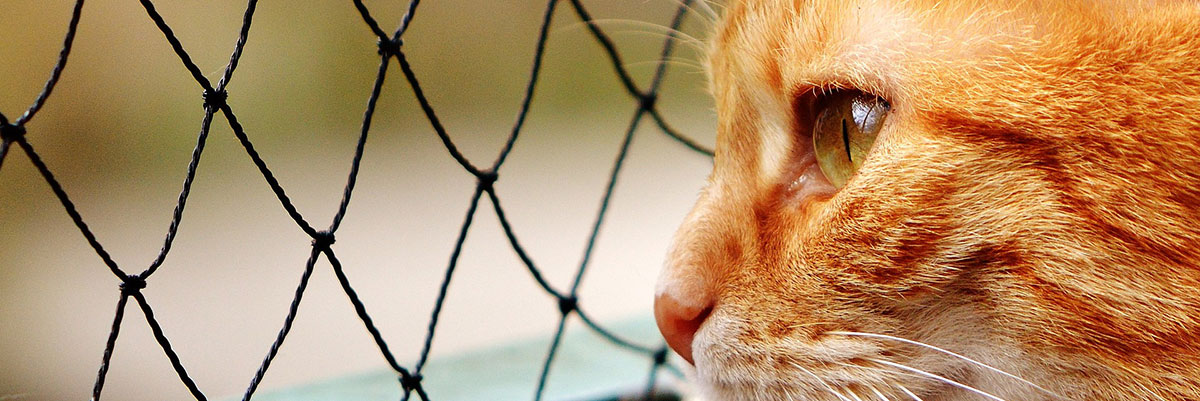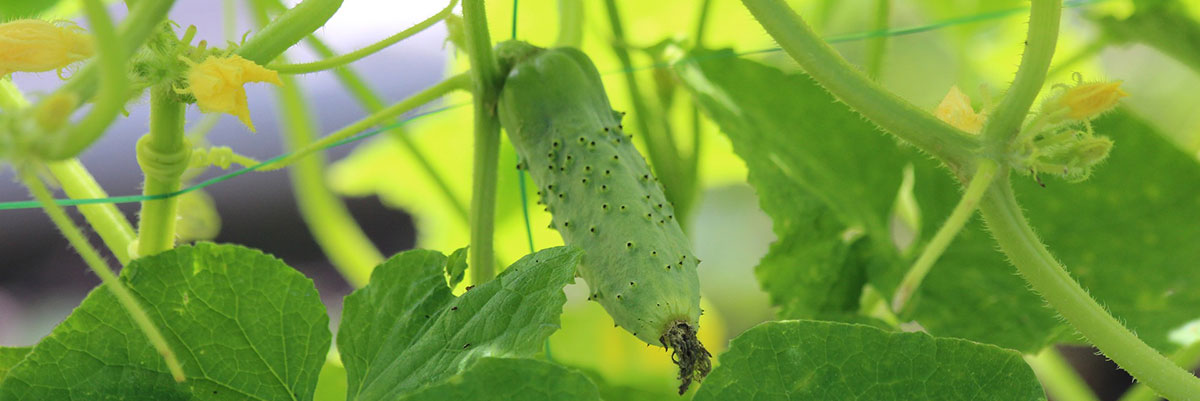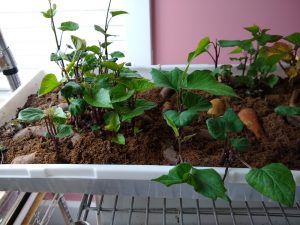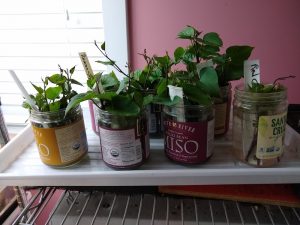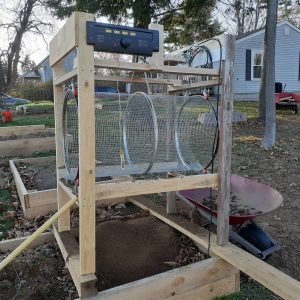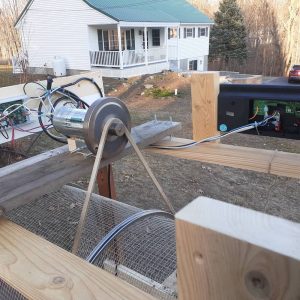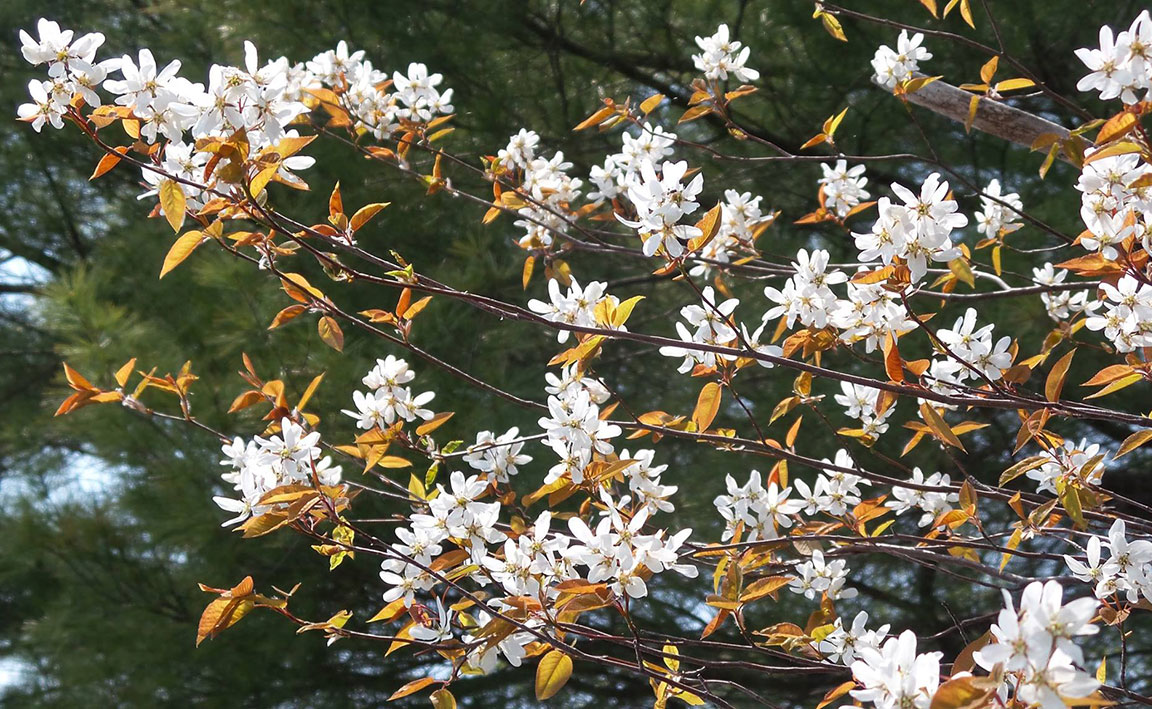
Maine Home Garden News — April 2021
In This Issue:
- April Is the Month for . . .
- Tips for Purchasing Healthy Plants and Seeds, and Preventing the Spread of Invasive Species
- Ask the Expert
- Plant Rotation in the Garden Based on Plant Families
- You Can Grow Sweet Potatoes in Maine
- Plant Monster: Creeping Bellflower (Campanula rapunculoides)
- A Review of A Year in the Maine Woods by Bernd Heinrich (1994)
- Reader Exchange
- Upcoming Learning Opportunities
April Is the Month for . . .
By Will Larson, Cumberland County Master Gardener Volunteer
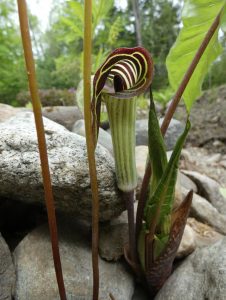 Starting (certain) native plant seeds: As long, cold periods of winter temperatures thaw into springtime sunshine, the natural window for sowing many native plant seeds has passed; many require an outdoor cold stratification in order for the seed to germinate. While early spring is a great time to observe these plants emerging in the wild, there are several native perennial seeds that will germinate without the need for chilly temperatures. These include popular garden plants like asters and campanulas, as well as other charming perennial additions which are not as frequently seen in cultivation, such as sundial lupine (Lupinus perennis) and jack-in-the-pulpit (Arisaema triphyllum). Many Rudbeckia species, like Rudbeckia hirta, will flower in their first year from seed and thrive in dry, sunny areas which are otherwise difficult to plant.
Starting (certain) native plant seeds: As long, cold periods of winter temperatures thaw into springtime sunshine, the natural window for sowing many native plant seeds has passed; many require an outdoor cold stratification in order for the seed to germinate. While early spring is a great time to observe these plants emerging in the wild, there are several native perennial seeds that will germinate without the need for chilly temperatures. These include popular garden plants like asters and campanulas, as well as other charming perennial additions which are not as frequently seen in cultivation, such as sundial lupine (Lupinus perennis) and jack-in-the-pulpit (Arisaema triphyllum). Many Rudbeckia species, like Rudbeckia hirta, will flower in their first year from seed and thrive in dry, sunny areas which are otherwise difficult to plant.
You can learn more about Maine’s native plants in Bulletin #2500, Gardening to Conserve Maine’s Native Landscape. For young people ages 10-18 interested in plants, sign up for the Virtual Native Seed Planting Workshop with 4-H on April 13, 2021, at 4:30 p.m.
You can also keep an eye out for these plants, and other great Maine plants, at the Cumberland County Master Gardener Plant Sale, which will run from Friday, May 28 until Tuesday, June 21, 2021, at the Falmouth Village Park.
- Maintaining tools: April is a great month for cleaning out and digging in, and it’s always important to go through your tools at the beginning of the season to clean and sharpen snippers, clippers, loppers, spades, and other choppers for the tasks ahead. See our article in the April 2018 issue of Maine Home Garden News, “Getting Your Garden Tools Ready for the Season” for a general overview, and “How to Clean and Sharpen your Pruners” from the UNH Extension. As early spring is a great time for pruning, before the buds are broken on trees, it’s important to practice good tool hygiene; clean cuts from well-honed pruners will heal faster and reduce the chance of infection.
- Sharing seeds: Swapping seeds with other gardeners is a fantastic way to share and experiment with new varieties, and also fills the gaps from any unforeseen shortages this year as a result of the pandemic. Exchange seeds with friends, or attend a seed swap, like the Southern Maine Seed Swap and Scion Exchange, on April 4, 2021, from 10 a.m.-1 p.m., hosted by The Resilience Hub, MOFGA, and Fedco Seeds. Read more about seed shortages in the article “Seed Shortages in 2021” from the University of Minnesota Extension.
- Taking a soil test: It’s always important to know what is going on with your soil. A test is the best way to gauge your garden’s nutrient demands. Read more in Know Your Soil, Bulletin #2286.
- Keeping a journal for plant identification: Strengthening your plant identification skills can be a deeply satisfying process, and it provides a new and exciting awareness of plants as they emerge and flower throughout the year. Native Plant Trust’s excellent Go Botany tool has many useful features in addition to field guides and print keys.
Here are some seeds you’ll want to sow*
| When | Sow Indoors** | Begin to Sow Outdoors |
|---|---|---|
| Early April | pepper, eggplant, broccoli, cabbage, cauliflower, coleus, statice, impatiens, larkspur, cosmos | |
| Mid-April | tomato, basil, lettuce, calendula, marigold | spinach, peas |
| Late April | swiss chard | beets, swiss chard |
*In coastal Maine, plant 10-14 days earlier. In northern Maine, plant 10-14 days later.
** With the exception of pepper, eggplant, coleus, and impatiens, all of the sow indoor options can also be seeded directly in the garden in late May.
Tips for Purchasing Healthy Plants and Seeds, and Preventing the Spread of Invasive Species
By Sarah Scally, Assistant Horticulturist, Maine Department of Agriculture, Conservation and Forestry – Division of Animal and Plant Health
 One bright spot of the pandemic is the increased interest in gardening, but how do new gardeners, or even seasoned gardeners, know that the plants they purchase are healthy and pest-free? In Maine, the Department of Agriculture, Conservation and Forestry (DACF), Horticulture Program, licenses and inspects businesses that sell plants. Two Assistant Horticulturists visit businesses selling plants and inspect for insects, diseases, weeds, and other plant health problems to ensure healthy plants are sold. These inspections give a snapshot of what pests may be present at a business at a point in time, but inspectors can’t be everywhere all the time. To ensure you purchase the healthiest, pest-free plant material, you can be your own inspector by following these tips:
One bright spot of the pandemic is the increased interest in gardening, but how do new gardeners, or even seasoned gardeners, know that the plants they purchase are healthy and pest-free? In Maine, the Department of Agriculture, Conservation and Forestry (DACF), Horticulture Program, licenses and inspects businesses that sell plants. Two Assistant Horticulturists visit businesses selling plants and inspect for insects, diseases, weeds, and other plant health problems to ensure healthy plants are sold. These inspections give a snapshot of what pests may be present at a business at a point in time, but inspectors can’t be everywhere all the time. To ensure you purchase the healthiest, pest-free plant material, you can be your own inspector by following these tips:
- Know what the plant you are purchasing should look like. In general, foliage should be green, not yellowed (unless of course, it is a variety that has naturally yellow leaves), not wilting, and leaves should be the shape and texture that is typical for the variety. Stems should be sturdy, not drooping, and with no discolored spots. Look at nearby plants of the same type; avoid plants that look substantially different from other similar plants.
-

Avoid purchasing plants infested with weeds. This maple has two invasive plants growing in the root ball: multiflora rose and oriental bittersweet. Look for signs of insects or disease. Check upper and lower leaf and petal surfaces and stems. Remember that some plant pests are small and may be hard to see without magnification. Look on leaves, petals, and stems for discoloration, puckering, crinkling or distortion, holes, wilting, webbing, or fuzzy growth. Do not purchase plants showing signs of pest infestation. Also, check pots or root balls for hitchhiking weeds.
- Purchase from a reputable, properly licensed source. This is especially important when ordering plants or seeds online, when it may be difficult to tell if the plants are coming from another state or country (see tip 5 below). When you purchase from a licensed seller, you have some assurance that the business is regularly inspected and is generally following rules regarding shipping and selling healthy plants.
- Maine maintains several quarantines on plant material to prevent the spread or introduction of certain plant pests. Depending on where you are in Maine and where the plants are coming from, you may be prohibited from purchasing hemlock trees, ash trees, currants, and gooseberries. In addition, Maine has a list of 33 invasive terrestrial plants and 11 invasive aquatic plants that cannot be sold in the state. Vendors may unintentionally have prohibited plants available, so we appreciate informed consumers alerting us to any that you may see for sale. Find more information about Maine’s plant pest quarantines and prohibited invasive plants on the maine.gov Horticulture Program website.
- Purchasing plants or seeds for planting from another country through an e-commerce site can be tricky. The purchaser must comply with all applicable U.S. import requirements, including obtaining an import permit from the United States Department of Agriculture – Animal and Plant Health Inspection Service (USDA-APHIS), obtaining a phytosanitary certificate from the national plant protection organization of the country of origin, properly labeling and shipping the plants and seeds, and meeting unique requirements for certain plant species and seed types. These requirements were completely ignored recently by an online vendor who sent thousands of packages of seeds to gardeners all over the country. Fortunately, it was only a marketing stunt and little or no invasive pests or noxious weeds were included in those shipments. In response, USDA-APHIS has added a new website to help purchasers understand the rules when purchasing seeds or plants from companies outside of the US.
Purchasing plants and seeds is one pathway that can introduce pests to your garden. Invasive insects, pathogens, and noxious weeds can all be moved to new areas on, or with, plants. To safeguard agriculture and the environment, USDA-APHIS and the DACF-Horticulture program regulate the importation of plants and seeds for planting, including plants and seeds purchased through e-commerce sites. By purchasing and planting healthy pest-free plants, not only are you helping to protect Maine’s plant resources, you are also giving your garden the best start for a successful and productive growing season.
Ask the Expert!
My neighbor’s cat used my vegetable garden as a litter box. Is it safe to plant and eat the vegetables from this garden?
Lynne M. Holland, Community Education Assistant, Androscoggin-Sagadahoc Counties
I have good news and bad news.
The good news is that if the “litter box” activity ended last Fall then after a “scoop” of any visible piles you should be fine. Anything in the soil itself has been killed by the winter weather extremes.
The bad news is that unless you stop the cat from getting in there once the snow melts this spring, you will not be able to use this bed for edible plants. I suggest covering the entire bed in a mulch fabric as soon as possible (even if there is a little snow). Normally, I would say newspaper or seaweed could work, but I think in this case a material such as landscape cloth or landscape plastic would be best. Then I would get some chicken wire or some hardware cloth and surround the garden bed completely so the cat moves on to other spaces. It doesn’t appear that talking to the neighbor is an option so you might also want to consider covering any sandbox-type play areas early in the season as well.
Cats are creatures of habit so if you can deter them early in the season you can make them learn a new habit. The secondary benefit is that you will have a mulched bed and if it is a dark color mulch, your soil will warm up soon. When it is time to plant, cut a small hole in the fabric or plastic where you want to plant, dig a hole, and place the plant in the hole.
Plant Rotation in the Garden Based on Plant Families
By Dr. Elsa Sánchez, professor of horticultural systems management, and Kathleen Demchak, senior extension associate, Department of Horticulture, Penn State College of Agricultural Sciences.
Knowing what family a plant belongs to can be useful in making decisions about rotating plants for managing pests and soil fertility in the garden. Plants in a family are genetically related, so they have similar characteristics. As an example, members of the Cucurbitaceae, among other shared characteristics, have deeply lobed or divided leaves, separate male and female flowers on each plant (termed “monoecious” plants) with five fused petals, and similar fruit types and tendrils for climbing. Besides having similarities in appearance, plants in the same family often have similar susceptibilities to various garden pests such as diseases, insects, and/or nematodes.
In general, it is not recommended that an area be planted with plants of the same family in succession to avoid the buildup of shared pests. Some plants should not follow members of other families because of susceptibility to common pests. For example, strawberries (and other members of the Rosaceae) should not be planted after members of the Solanaceae (and vice versa) because they are all susceptible to the disease verticillium wilt. Keep in mind that various weeds also belong to these same families and can also host the same pests. Knowing plant families can also be useful in determining appropriate pesticides to use, when warranted. This can apply to both targeted effects and non-targeted effects such as being toxic to desirable garden plants.
Plants can be rotated to manage soil fertility. This is done by including plants in the rotation to improve the fertility status of the garden soil and rotating among plants that are heavy users of certain nutrients. For example, members of the Fabaceae (legume family) can be grown to add nitrogen to the soil and many members of the Liliaceae are heavy users of potassium.
The table below lists several vegetables, herbs, fruit, cut flowers, bedding plants, cover crops, and weeds by plant family. Plant family names can be easily identified because they end in “-aceae”; however, some families also have “old” or traditional names that end in “-ae.” Traditional names, as well as common names, are included in the table. Note that some plants are listed in more than one grouping.
| Family Name | Alias | Crops and Cover Crops | Herbaceous Ornamentals | Weeds |
|---|---|---|---|---|
| Solanaceae | solanaceous crops; potato, tomato, or nightshade family | peppers (bell and chile), tomatoes, potatoes, eggplant, tobacco, tomatillo | petunia, million bells | nightshade, jimsonweed, henbane, groundcherry, buffalobur, horsenettle |
| Brassicaceae | Cruciferae; brassicas; cole crops; cruciferous crops; mustard family | horseradish, cabbage, cauliflower, broccoli, kohlrabi, kale, Brussels sprouts, turnips, Chinese cabbage, radish, rapeseed, mustard, collards, watercress, pak choi, bok choi, rutabaga | stock, alyssum, candytuft | shepherd’s-purse, field pennycress, yellow rocket |
| Cucurbitaceae | cucurbits; cucumber family; squash family | cucumber, melons, watermelon, summer squash, pumpkin, gourds, winter squash | ||
| Rosaceae | rose family, rosaceous plants | apples, peaches, apricots, nectarines, plums, strawberries, blackberries, raspberries, pears, cherries, quince, almond |
multiflora rose | |
| Fabaceae | Leguminosae; leguminous crops; legumes; bean, pea, or legume family |
beans, peas, lentils, peanut, soybean, edamame, garbanzo bean, fava bean, hairy vetch, vetches, alfalfa, clovers, cowpea, birdsfoot trefoil, black medic | various vetches, clovers, black medic | |
| Poaceae | Gramineae; grass family | corn, wheat, barley, oats, sorghum, rice, millet, rye, ryegrass, sorghum-sudangrass, fescue, timothy |
ornamental grasses | brome, wild oats, crabgrass, orchardgrass, barnyardgrass, quackgrass, fall panicum, foxtail, Johnson grass |
| Polygonaceae | knotweed family | buckwheat, rhubarb | knotweed, smartweed | |
| Liliaceae | lily family; alliums (for members of the Allium genus) | asparagus, onions, leeks, chives, garlic, shallots | tulips, daffodils, hosta, hyacinth | wild garlic and onions |
| Lamiaceae | Labiatae; mint family | lavender, basil, marjoram, oregano, rosemary, sage, thyme, mints, catnip | salvia, Molucella (bells of-Ireland) | mints, catnip, henbit |
| Ericaceae | heather or blueberry family | blueberries, cranberries | heather | |
| Chenopodiaceae | goosefoot family | spinach, beets, chard, sugar beets | kochia, lambsquarters | |
| Apiaceae | Umbelliferae; carrot family | carrots, parsnips, celery, dill, chervil, cilantro, parsley, caraway, fennel | Trachymeme, Buplerum | poison-hemlock, wild carrot |
| Asteraceae | sunflower family; aster family | sunflowers, lettuce, endive, escarole, radicchio, dandelion, Jerusalem artichoke, artichoke, safflower, chicory, tarragon, chamomile, echinacea | marigold, mums, zinnia, aster, Calendula, cosmos, Rudbeckia, Tithonia, Centaurea, Helichrysum, yarrow, Leucanthemum, echinacea, sunflowers | dandelion, Jerusalem artichoke, chicory, echinacea, thistles, knapweeds, cocklebur, yarrow, ragweeds, goldenrod, groundsel, galinsoga, sunflowers |
You Can Grow Sweet Potatoes in Maine
By Tom Witwicki, Cumberland County Master Gardener Volunteer
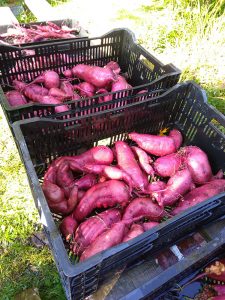 Many people think of sweet potatoes as a southern crop. However, with the right growing treatment, this high yielding, nutrient-dense crop can successfully be grown even in the North. They are also easy to store if cured properly, keeping well into the spring (or even longer if you don’t run out). I’ve grown sweet potatoes for three years now in my home garden in Cape Elizabeth and every year the yield just amazes me when I dig into one of the hills. Just one sweet potato slip easily will yield 6 or 7 pounds. Read on for the techniques needed to grow your own.
Many people think of sweet potatoes as a southern crop. However, with the right growing treatment, this high yielding, nutrient-dense crop can successfully be grown even in the North. They are also easy to store if cured properly, keeping well into the spring (or even longer if you don’t run out). I’ve grown sweet potatoes for three years now in my home garden in Cape Elizabeth and every year the yield just amazes me when I dig into one of the hills. Just one sweet potato slip easily will yield 6 or 7 pounds. Read on for the techniques needed to grow your own.
Starting the Slips – Late March, Early April
Unlike standard potatoes, which are a member of the nightshade family, sweet potatoes are related to the morning glory and require very different growth practices. Sweet potatoes are grown from “slips,” which are sprouted from a mature tuber. One technique you probably remember from your school days is to suspend a sweet potato in a jar of water with toothpicks with the sprouts growing from the top. I’ve used this method with some success, but have found a far easier method.
Fill a standard 1020 solid bottom seedling tray with growing medium. A smaller tray or flat container works fine if you don’t need many slips. Lay sweet potatoes flat in the tray and half-bury with coir or peat-based seed starting mix. You can count on each potato to produce 4-5 slips. Water, cover the tray with a humidity dome, and place under lights or in a sunny window. Sweet potatoes like heat, so placing a seedling heat mat under the tray will improve and speed up the slip production. Keep the medium moist but not wet.
-
Lay sweet potatoes flat in the tray and half-bury with coir or peat-based seed starting mix.
-
After the sprouts get to about 6 inches in length, cut them from the potato at the base and place in a jar of water to develop the roots.
In about 2 weeks, the sprouts will start to appear. As the sprouts get to about 6 inches in length, cut them from the potato at the base and place in a jar of water to develop the roots. If the slips start to vine and get too long, you can cut the tops and use them to root additional slips.
Your seed potatoes will continue to produce slips for a few weeks. After the roots have developed, these slips can be planted directly, but I use an additional step of potting them in 4-inch pots to get an additional head start. One thing I’ve learned from past years is not to start the slips too early. About 8 weeks before your last frost date is about right. If started too early, the roots tend to intertwine and the resulting sweet potatoes which develop on these roots can be deformed.
Varieties and Sources
Any organic sweet potato from your local grocery store can be used to start your slips. You can also use your own stored sweet potatoes to start slips for the next season. The ideal size of the tubers to start slips is about 1 ½ inches in diameter. I’ve had very good results with Red Garnet and Purple Stokes. I’ve tried Beauregard, but the yield seems to be less. This past year, I tried Georgia Jet and Carolina Ruby, which have been developed specifically for northern growers. These aren’t available locally in the stores as sweet potatoes, so I purchased them as slips from a grower in Tennessee*.
Planting and Harvesting
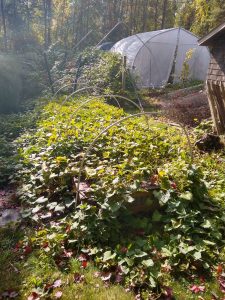
Did I say that sweet potatoes like heat? Delay planting until the weather has had time to warm up the soil in the planting bed; this should be in early June in the Portland area. In years past, I have used black plastic on the beds two weeks in advance of planting. This year I’m going to use clear plastic, which should do a better job of warming up the soil. I space the slips in a single row about 18 inches apart in a 30-inch wide bed. Slit the plastic, make a small depression in the soil and set the slip. The depression will ensure the plants get water when you water or it rains. I also use drip irrigation to ensure the soil stays moist but not waterlogged. I also cover the beds with row cover supported by hoops until early July. The plants will put out vines that spread but don’t climb. I’ve never been bothered by insects or disease, but do use a seaweed foliar spray during the growing season.
Delay harvesting as long as possible in the fall to give the tuber a chance to develop. I usually harvest in advance of the first frost, but it’s OK to wait until a mild frost as long as you harvest immediately after. Be careful lifting the tubers because the skins are very delicate at this point. The tubers should be “cured” to toughen the skins and sweeten them. This is done by holding them in conditions of high temperatures and high humidity for about 8 days.
*Maine-based vendors for sweet potatoes include Maine Potato Lady, FEDCO, and Johnny’s Selected Seeds. No endorsement of companies is intended, nor is criticism of unnamed companies implied.
Plant Monster: Creeping Bellflower (Campanula rapunculoides)
Be afraid . . . be very afraid . . .
By Naomi Jacobs, Penobscot County Master Gardener Volunteer

Most human families have at least a few disreputable members, and plant families are no different. The bellflower family (Campanulaceae) is best known for beautiful cottage-garden plants such as the peach-leaved bellflower (Campanula persicifolia) with its tall spires of blue and white, the charming mound-forming Carpathian bellflower (Campanula carpatica), balloon flower (Platycodon), and lobelia.
However, one member of the clan is a true thug: Campanula rapunculoides, the creeping or European bellflower. Native to Europe and temperate Asia, it has taken hold as an invasive species in most of the northern tier of the United States. You’ve certainly seen it growing in fields, banks, meadows, roadside banks, woodland edges, and perhaps even your own garden beds or lawn.
Information about C. rapunculoides often contains the dreaded phrase, “no effective control.” The plant adapts to a wide range of soils, moisture levels, and light conditions. It self-seeds freely, with each plant capable of producing as many as 15,000 seeds, and it spreads aggressively underground through rhizomes.
Fleshy taproots enable the plant to survive long periods of drought, while fine, brittle feeder roots creep horizontally to invade new territory. Because the tiniest fragment of root can produce a new plant, digging out a clump is rarely a complete success, and tilling will simply worsen the problem. Chemical herbicides can reduce a stand in the year of treatment, but plants will probably reappear the next year.
No villain is completely evil. The creeping bellflower’s purple flowers can be attractive, and its greens and taproots are both edible. In fact, the species name comes from the Latin word rapa, which means “turnip.” The German vegetable known as rampion or rapunzel, which plays a role in the Grimm Brothers’ fairy tale of the same name, is a close relative of C. rapunculoides.
So what to do if this bellflower has crept its way into your garden? You will probably not be able to eradicate it, but here are a few strategies to discourage its spread.
Know your enemy
The foliage of creeping bellflower resembles that of our native pollinator magnet, the heart-leaved aster (Symphyotrichum cordifolium). Try not to let this aster be collateral damage in your campaign against C. rapunculoides.
When in bloom, creeping bellflower is easily confused with ladybells (Adenophora), an ornamental bellflower with a more restrained habit. Adenophora should not be blamed for the crimes of its evil twin.
Pulling and hoeing
You might be tempted to let the flowers bloom. But since seeds can ripen before bloom is complete, it’s important to yank out the stalks as soon as flowers appear.
Hoeing out the top growth won’t kill the plant but can reduce its vigor if repeated every couple of weeks through the season.
Digging
With smaller infestations, try physical removal. Dig down at least six inches from the edge of the clump and then underneath the clump at a depth of 6-8 inches. Once you have loosened the soil, lift the clump with a garden fork rather than a spade to reduce the chances of leaving pieces behind that will develop into new plants.
Dig down even further to make sure you have gotten all of the taproots. Sift through the loose soil with your fingers or put it through a garden sieve to remove the bright white feeder roots, which are easy to see.
If bellflower roots have invaded the roots of other plants, you will need to make a judgment call. Disentangling them is very difficult with tight-rooted species like coreopsis and ornamental grasses. In some cases, the wisest choice is to throw out the good with the bad.
Burn the foliage and roots or discard them with your trash in a plastic bag. DO NOT PUT THEM IN THE COMPOST.
Smothering
Starving the plants of light and moisture can bring some success. Mulch alone will have little effect. Instead, put down heavy layers of cardboard or newspaper and cover with mulch for the season. Plants will still peek out at the edge of the barrier, but the stand will be reduced.
Dense plantings of large-leaved hostas or other vigorous groundcovers can also smother out bellflower. However, be careful not to create a new problem by introducing an invasive groundcover like bishop’s weed.
Chemical measures
Chemical herbicides may have a short-term impact on this monster, but they are unlikely to solve the problem. This fact sheet from the University of Wisconsin Cooperative Extension provides details on the relative effectiveness of various products: Creeping bellflower (PDF)
When all else fails, learn to live with it.
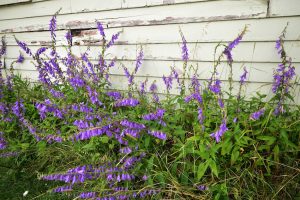
I tried for years to eliminate bellflower from one particular bed where perennials and bulbs were planted. Every spring I would dig up the bellflower and attempt to screen out every piece of root. But by bulb planting time in fall, the roots had always re-invaded the area, and I’d find myself repeating the process in a very bad humor.
I cut my losses by converting the whole area to a tulip bed. In fall, when digging holes for mass tulip plantings, I discard the larger bellflower roots I find, but don’t attempt to remove every fragment. In spring, I ignore the bellflower that inevitably emerge among the tulips. Then after the tulip foliage has died back, I fill in those areas with big containers of annuals to smother the bellflowers. This routine does seem to have discouraged the bellflowers, and in any case, has reduced by half the time I spend on battling the villainous C. rapunculoides.
A Review of A Year in the Maine Woods by Bernd Heinrich (Addison-Wesley Publishing Co., 1994)
Reviewer: Abby Zelz, Penobscot County Master Gardener Volunteer

When he considers some of the reasons for spending a year in a cabin in the woods of western Maine, naturalist and zoology professor Bernd Heinrich reflects,
“Sometimes lately I have begun to wonder if it is still possible to taste the world up close as I did as a child. I long to see nature again as I did then — fresh, clear, timeless, and shrouded in magic. Would it be possible to rediscover the vividness that I now experience only as brief, tantalizing flashbacks?”
As a professor at the University of Vermont, Heinrich is anxious to spend a year immersed in the natural world, on his own schedule.
The result of his experience is A Year in the Maine Woods. Heinrich arranged the book chronologically, beginning with his move to the cabin at the end of May with his raven Jack.
While observing Jack’s behavior, as well as animal life and flowering woodland plants nearby, he settles into his cabin, which has no electricity or running water. Located near a brook, it’s an uphill walk from his nearest neighbors. Heinrich hauls water from a well, builds an outhouse, cooks and heats his cabin with wood stoves, and illuminates his home with kerosene lamps. Apart from the time that these tasks require, Heinrich isn’t bothered by the lack of creature comforts. For him, “creature comforts” are the familiar creatures that he studies.
Heinrich invites readers to share his detailed observations, musings, questions, and enjoyment of his wooded surroundings. In preparation for winter, he clears trees and brush, cuts and stacks firewood, chinks the logs to eliminate drafts, and plants a vegetable garden.
Gardeners may be disappointed that Heinrich’s detailed observations about his surroundings don’t include his vegetable garden. His garden provides beans, squash, and other sustenance, but it doesn’t hold the same fascination for him as the native plants and animal life.
Heinrich isn’t a hermit; he enjoys breakfasts at the local diner, gatherings with neighbors, and he hosts family, friends, and students. His reasons for leaving his Vermont home to live in the woods for a year are not those of Henry David Thoreau.
He explains, “For the past twenty-five years I’ve been teaching at a university, which means what I also do is fill out forms, read memos, and sit in meetings. Sometimes I apply for grants, and sometimes I write papers, but what I really want to do . . . is to be out in the woods.”
Throughout his year in the woods, he observes, records, and shares the sights, sounds, and smells, of the animal world and of plant life. Like a member of an audience watching musicians arrive on stage and tune their instruments before a performance, Heinrich pays close attention to the birds and insects — when he first hears the calls of specific bird and insect species in the day and in the season, and, as the weeks and months pass, when they fall silent. Some species sing in the darkness before dawn, others warble at first light or later. Similarly, he chronicles the behavior and life cycles of insect life that surrounds him, from pesky black flies to moths, butterflies, beetles, and spiders. Pleased to be able to devote himself full time to the study of nature, he writes, “I can spend hours per day wondering about ‘useless’ things.” Heinrich’s “useless” musings are not useless, of course — they pertain to adaptability, survival, and other aspects of the natural world.
Heinrich is acutely in tune with both a broad view of the region and the small details, from the swaths of clear-cut timber to the tiny insect larvae and plant, animal, and bird life that surround him. He describes how the receding glaciers formed the region, and by reading the landscape, traces the occupancy of the area by Native people and later, generations of Maine farmers. Remnants of old apple orchards, old logging roads that have become deer and moose trails, and previously logged acreage offer clues about the land, its use, and the resulting changes in plant and animal life. When focusing on smaller details, he also provides sketches of plants in various stages of budding, flowering, or producing berries; caterpillars becoming moths; fish, and more.
Swimming, berry picking, fishing, attending local events, and visiting friends punctuate his year. Besides being an astute observer of plant life and animal behavior, Heinrich is also a long- distance runner, and during one of his frequent runs in the fall, he follows a deer trail, only to encounter a large bull moose. To avoid a confrontation, he scrambles up a maple tree, and from his elevated vantage point, watches the animal until it retreats.
Now retired, Heinrich is the author of 22 books, most about the natural world. He is also the subject of the 2011 documentary An Uncommon Curiosity: at home and in nature with Bernd Heinrich.
Reader Exchange
Our readers have a lot of experience and great ideas. Therefore, we decided it’s high time you chimed in with some of your favorite gardening tips and tricks. Each month, we’ll challenge you to send us gardening “hacks” that make your horticultural life more fun and productive. If your submission is selected, we’ll provide you with a free soil test with the Maine Soil Testing Service. Submit your ideas to katherine.garland@maine.edu with the email subject “Reader Exchange.”
To start us off, we gleaned inspiration from a discussion post from our NEW online Master Gardener Volunteer training.
Building a dirt trommel using recycled materials
“My soil is extremely rocky so I have used a 2’x3′ wood-framed screen to separate out the rocks from my soil. When I set up my most recent garden beds last year I needed to dig into a small hillside to keep the beds level. To save money I wanted to use as much of my soil as possible, which meant I had a lot of rocks to remove and my little soil sifter wouldn’t cut it. My son and I built a dirt trommel using recycled materials. We used scrap 2×4 for the frame, bicycle wheels and hardware cloth for the trommel, and a treadmill motor to power it. I shovel soil in one end, the soil falls through the screen while the big rocks tumble out the end into a wheelbarrow. What would have taken me weeks to finish was done in just a couple of days.”
— Stewart McCallister, Cumberland County Master Gardener Intern
Upcoming Learning Opportunities
Tractor Safety Training
The 2021 Tractor Safety training, offered by the University of Maine Cooperative Extension, is designed for adults and youth at least 14 years old, and required for 14- and 15-year-olds who plan to operate farm equipment for hire on farms other than their own family’s farm. The class will be a hybrid of self-paced online learning, Zoom classes, and in-person tractor driving experience, which will take place at two locations — Gorham Public Works, Gorham; and Kennebec Valley Community College, Hinckley. Applications are due April 4 and the class begins April 14. See the full schedule for more information.
April Gardening Webinars
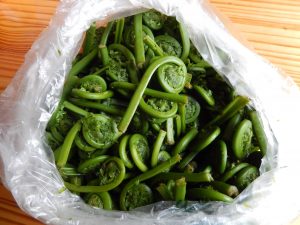 Presented by University of Maine Cooperative Extension and the University of New Hampshire Cooperative Extension.
Presented by University of Maine Cooperative Extension and the University of New Hampshire Cooperative Extension.
Registration is required with a $5 suggested donation (optional) for each webinar. Participants will receive the Zoom information after registering for a webinar. All sessions will be recorded and shared with participants following the event. If you can’t attend the live session, please register to receive a link to the recording and a resource list.
- Fiddleheads: A Spring Tradition: Wednesday, April 14, 6:00 – 7:15 PM. Register online (registration closes at 4:00 PM on April 14).
- Weed Management for the Perennial and Ornamental Landscape: Wednesday, April 28, 6:00 – 7:15 PM. Register online (registration closes at 4:00 PM on April 28).
Do you appreciate the work we are doing?
Consider making a contribution to the Maine Master Gardener Development Fund. Your dollars will support and expand Master Gardener Volunteer community outreach across Maine.
Your feedback is important to us!
We appreciate your feedback and ideas for future Maine Home Garden News topics. We look forward to sharing new information and inspiration in 2020.
Subscribe to Maine Home Garden News
Let us know if you would like to be notified when new issues are posted. To receive e-mail notifications, click on the Subscribe button below.
University of Maine Cooperative Extension’s Maine Home Garden News is designed to equip home gardeners with practical, timely information.
For more information or questions, contact Kate Garland at katherine.garland@maine.edu or 1.800.287.1485 (in Maine).
Visit our Archives to see past issues.
Maine Home Garden News was created in response to a continued increase in requests for information on gardening and includes timely and seasonal tips, as well as research-based articles on all aspects of gardening. Articles are written by UMaine Extension specialists, educators, and horticulture professionals, as well as Master Gardener Volunteers from around Maine, with Katherine Garland, UMaine Extension Horticulturalist in Penobscot County, serving as editor. Special thanks to our 2020 Master Gardener Volunteer co-editors Naomi Jacobs and Abby Zelz.
Information in this publication is provided purely for educational purposes. No responsibility is assumed for any problems associated with the use of products or services mentioned. No endorsement of products or companies is intended, nor is criticism of unnamed products or companies implied.
© 2021
Call 800.287.0274 (in Maine), or 207.581.3188, for information on publications and program offerings from University of Maine Cooperative Extension, or visit extension.umaine.edu.
The University of Maine is an EEO/AA employer, and does not discriminate on the grounds of race, color, religion, sex, sexual orientation, transgender status, gender expression, national origin, citizenship status, age, disability, genetic information or veteran’s status in employment, education, and all other programs and activities. The following person has been designated to handle inquiries regarding non-discrimination policies: Director of Equal Opportunity, 101 North Stevens Hall, University of Maine, Orono, ME 04469-5754, 207.581.1226, TTY 711 (Maine Relay System).

